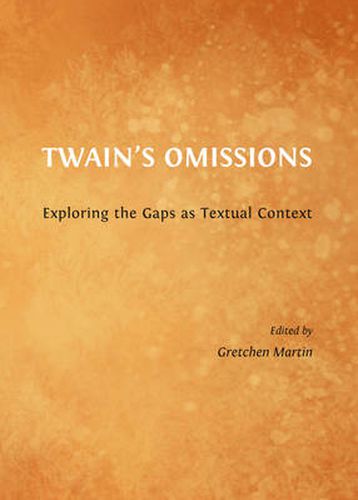Readings Newsletter
Become a Readings Member to make your shopping experience even easier.
Sign in or sign up for free!
You’re not far away from qualifying for FREE standard shipping within Australia
You’ve qualified for FREE standard shipping within Australia
The cart is loading…






Mark Twain utilized a unique literary device throughout his fiction by routinely omitting or suspending crucial information in terms of plot, character portraits, descriptive events, chronology, and other aspects from his texts. Twain often introduces characters with very few details regarding their personal histories; while, other information is withheld in terms of the narrative’s chronology or not addressed at all, thus producing gaps in the narrative. For example, Twain does not provide any significant information about the mothers of two of his most well-known characters, Huckleberry Finn and Tom Sawyer, nor does he provide detailed information regarding Jim’s personal history, such as how and when he became Miss Watson’s property or specific information regarding the personal history of his relationship with his wife. There are also often substantial chronological gaps in the pace Twain utilizes. There are omissions of several years at a time in Pudd'nhead Wilson and No. 44, The Mysterious Stranger, which also create gaps in the plot, particularly regarding information Twain refers to that occurred during the chronological gap, such as an account of the wedding between Morgan and Sandy in A Connecticut Yankee in King Arthur’s Court. Identifying and exploring gaps in the context of Twain’s fiction yields, as these essays demonstrate, overlooked or under-explored information, ironically generated out of these narrative omissions. The six essays included in this collection explore these issues in A Connecticut Yankee in King Arthur’s Court, No. 44, The Mysterious Stranger, Pudd'nhead Wilson, The Man that Corrupted Hadleyburg, and Twain’s masterpiece, Adventures of Huckleberry Finn. The authors draw from a wide range of theoretical and interpretive perspectives, ranging from reader-response theory to historical and culture studies.
$9.00 standard shipping within Australia
FREE standard shipping within Australia for orders over $100.00
Express & International shipping calculated at checkout
Mark Twain utilized a unique literary device throughout his fiction by routinely omitting or suspending crucial information in terms of plot, character portraits, descriptive events, chronology, and other aspects from his texts. Twain often introduces characters with very few details regarding their personal histories; while, other information is withheld in terms of the narrative’s chronology or not addressed at all, thus producing gaps in the narrative. For example, Twain does not provide any significant information about the mothers of two of his most well-known characters, Huckleberry Finn and Tom Sawyer, nor does he provide detailed information regarding Jim’s personal history, such as how and when he became Miss Watson’s property or specific information regarding the personal history of his relationship with his wife. There are also often substantial chronological gaps in the pace Twain utilizes. There are omissions of several years at a time in Pudd'nhead Wilson and No. 44, The Mysterious Stranger, which also create gaps in the plot, particularly regarding information Twain refers to that occurred during the chronological gap, such as an account of the wedding between Morgan and Sandy in A Connecticut Yankee in King Arthur’s Court. Identifying and exploring gaps in the context of Twain’s fiction yields, as these essays demonstrate, overlooked or under-explored information, ironically generated out of these narrative omissions. The six essays included in this collection explore these issues in A Connecticut Yankee in King Arthur’s Court, No. 44, The Mysterious Stranger, Pudd'nhead Wilson, The Man that Corrupted Hadleyburg, and Twain’s masterpiece, Adventures of Huckleberry Finn. The authors draw from a wide range of theoretical and interpretive perspectives, ranging from reader-response theory to historical and culture studies.